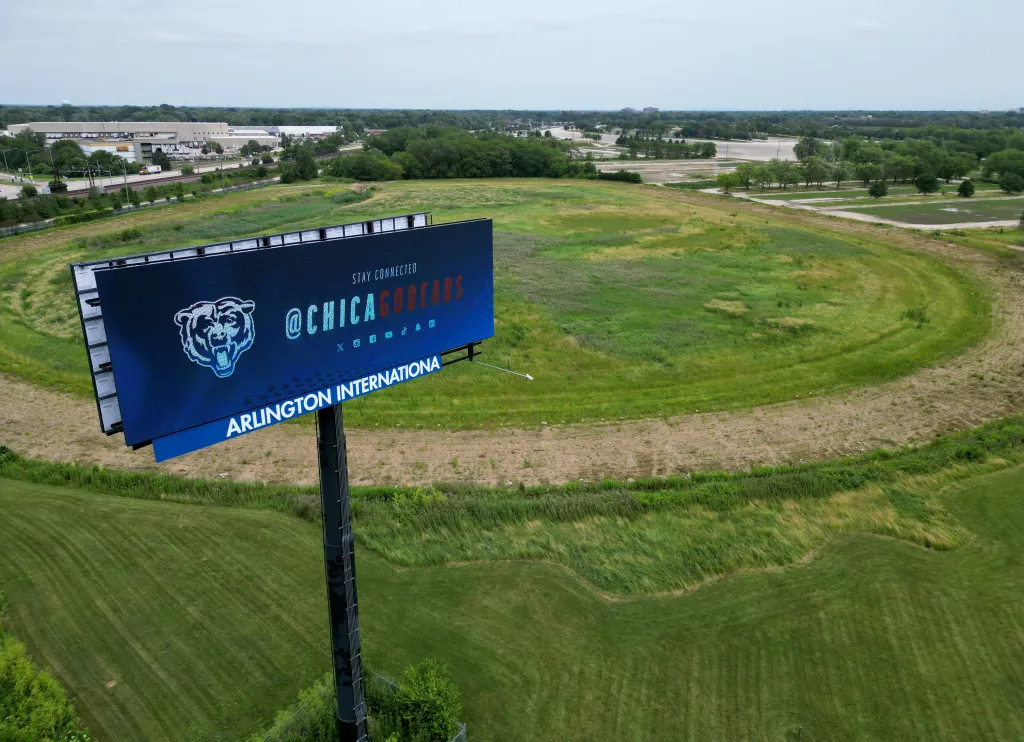
The Chicago Bears embarked on a new era in February 2023 with the purchase of a site in Arlington Heights where the team hopes to build a new enclosed stadium with a massive entertainment and residential development.
In April 2024, the team laid out elaborate plans for a new publicly owned domed stadium, but now, the storied NFL franchise’s sights are focused on the northwest suburbs.
Here’s what to know about the long road to a new stadium.
The latest development
Construction of a new Chicago Bears stadium in Arlington Heights would generate thousands of jobs and billions of dollars in economic activity, but would also require substantial taxpayer support for infrastructure, according to team projections released on Sept. 30.
Infrastructure such as entrance and exit ramps from near Route 53 and changes to the adjacent Metra train line would cost $855 million in public funds, the team’s consultant estimated in its report. The report attempts to assuage concerns about the price tag by pointing to gross state tax revenues of almost $1.3 billion over 40 years, according to projections from HR&A Advisors, Inc.
Kevin Warren all but shuts the door on Chicago Bears staying in city in letter to fans
The Bears all but slammed the door on building an enclosed stadium in the city, with team president Kevin Warren writing in a letter to fans on Sept. 8 that the team’s “future home” is in Arlington Heights.
“Moving outside of the city of Chicago is not a decision we reached easily,” Warren said. “This project does not represent us leaving, it represents us expanding. The Bears draw fans from all over Illinois, and over 50 percent of our season-ticket holders live within 25 miles of the Arlington Heights site.”
Warren made it clear the team is committed to building a stadium, saying “this is the year” to finalize plans so the team could bid to host a Super Bowl “as soon as 2031.” He said the stadium would “require zero state money for construction,” but the team would need the legislature to pass a bill in October to start construction this year.
As other NFL teams build new stadiums, the Bears will soon release plans for a new dome in Arlington Heights
Bears are shifting their stadium focus to Arlington Heights
4 things we learned from Bears brass, including a renewed push for legislative help on stadium project
Bears’ proposed move to Arlington Heights would require complicated approval by local taxing bodies
Arlington Heights approves tax deal with Bears
Bears to submit traffic and financial studies for Arlington Heights stadium site, official says
Bears face a long drive to get passage of stadium legislation in the fall
The Bears’ playbook for constructing a new domed stadium and football entertainment complex in Arlington Heights calls for state lawmakers to act in October to approve property tax break legislation that would allow them to break ground this year.
But it is the Bears’ pocketbook that may be more important in getting legislators’ votes, particularly those from Chicago, to ease the way for one of the NFL’s founding franchises to leave the city it has called home for 104 years, since George Halas moved the Staleys from Decatur.
Already, there is $525 million in outstanding public debt from the controversial 2003 Soldier Field renovation, a tab currently covered by city hotel taxes and, when that falls short, by Chicago’s share of state income taxes. The Bears’ lease at Soldier Field expires in 2033, but it can be broken early with a penalty, and the team says it will take three years to build its new stadium.
But even if the Bears were forced to pay off the outstanding debt, that alone is unlikely to be enough to satisfy city lawmakers who are key in providing the necessary votes to advance any legislation to help the team.
Bears and Gov. JB Pritzker have quietly hired outside consultants for stadium talks
Rep. Kam Buckner: Springfield should think twice before giving the Bears a property tax break
Bears’ stadium efforts run out of time in Springfield, but suburban lawmaker says deal was close
As Bears pivot to Arlington Heights, Mayor Brandon Johnson says ‘I’ve done my part’
A skeptical Springfield awaits after Bears pitch stadium plan backed by mayor
True public cost of Bears stadium would be billions more over time
Arlington Park’s rebirth
One week before his inauguration as the new mayor of Arlington Heights, Jim Tinaglia walked through the downtown streets he’s called home for more than 50 years. What was once a “sleepy little town,” as he described it, has become a bustling community, a place Tinaglia has had a hand in building, himself, through his work as an architect.
He’d built “at least a dozen” places here over the past 35 years.
If there’d been a constant amid all the growth in one of Chicago’s largest suburbs it was probably the horse racing track a little ways northwest of downtown, the one now locked away and waiting for new life. For decades, Arlington Park had been a deeply-ingrained part of the culture here, and a source of pride.
“Our identity,” Tinaglia said of the track. “For 100 years.”
Now it will be his mission to lead Arlington Park’s rebirth — to complete the long, winding journey of bringing the Bears to Arlington Heights. It’s a large part of why he ran for mayor, and also why he believes he was elected: to finish a deal that has proven elusive since a rush of early momentum, and to help convince Bears leadership, once and for all, that they should move from Chicago to the northwest suburbs.
Bears show renderings for enclosed stadium complex in Arlington Heights, but say they’d expect some public funding for surrounding entertainment district
Newly seated Arlington Heights trustees get rundown on Bears plans to move to Arlington Heights: ‘We’ve still got a long, long way to go’
Some Arlington Heights residents decry lack of input in possible stadium move: ‘Bears should stay in Chicago where they belong’
Bears’ plans for stadium in Arlington Heights excite many suburbanites. But with funding a big issue, economists caution about subsidies.
Arlington Heights mayor denies claims of pressuring school districts in ongoing Bears land dispute
A domed stadium on the Chicago lakefront?
Warren envisions a stadium just south of the Bears’ current home at Soldier Field, on the site of what is now a parking lot. The facility would seat about 65,000 for football, with standing room up to 70,000, and a capacity of 77,000 for basketball.
Unlike Soldier Field, it could hold events year-round, including concerts, soccer, college basketball playoffs, or, once in a great while, the Super Bowl.
Soldier Field would be torn down, but its colonnades would be saved and 14 acres of athletic fields and open space added in between and to the north of the colonnades, for use by local sports teams, graduations and other events. If approved this year, the stadium would open in 2028.
The Bears say they would pay $2 billion, a huge private investment, plus $300 million requested from the NFL. The rest of the $3.2 billion cost of the stadium alone would be paid with $900 million from the state. The team said another $325 million would be needed for infrastructure, including improved road access and utilities as part of up to $1.5 billion for full build-out with extras like a hotel.
The public money would be borrowed through bonds issued by the Illinois Sports Facilities Authority, or ISFA, which previously financed construction of Guaranteed Rate Field, where the White Sox play, and the 2003 renovation of Soldier Field. The bonds are to be repaid over 40 years by the city’s 2% hotel tax.
“I remain skeptical about this proposal, and I wonder whether it’s a good deal for the taxpayers,” Gov. J.B. Pritzker said. “There are a lot of priorities that the state has, and I’m not sure that this is among the highest priorities for taxpayers.”
Friends of the Parks, a not-for-profit group that advocates for the city’s Lakefront Protection ordinance, which limits the lakefront to public use, criticized the stadium plan as rushed and not transparent, comparing it in a statement to other faltering mega-developments like The 78 and Lincoln Yards.
Bears’ domed stadium proposal sparks excitement, questions — and early opposition
Chicago community groups join forces to oppose new Bears stadium on the lakefront
Could Indiana be an option?
The Indiana legislature moved a bill aimed at attracting the Bears to Northwest Indiana just yards from the end zone, with final approval by the Senate on April 9.
House Bill 1292, authored by Rep. Earl Harris, D-East Chicago, would establish a Northwest Indiana professional development commission and a professional sports development fund. The commission would be tasked with exploring and implementing strategies to attract one or more sports franchises to Northwest Indiana, Harris said.
The bill passed the Senate 46-2.
“The Bears are the big boy, so that has received the most attention,” Harris said. “Honestly, I would love it if the Bears moved their location over to Northwest Indiana, but we are open to any sport.”
What about another site in Chicago?
The Bears are reconsidering the former Michael Reese Hospital site as a potential location for a new stadium, a source said, but the team remains focused on the lakefront.
The team is open to any alternative that would work, but officials have said previously that the former hospital site was unworkable because it’s next to Metra train tracks that pose a security risk. The 49-acre site is limited because it’s long and skinny, sandwiched between the tracks and DuSable Lake Shore Drive on the east, apartments on the west, 31st Street on the south and the Stevenson Expressway to the north.
The advantage of the site is that it’s mostly open land, not far from the Loop and the lake, and next to McCormick Place Convention Center. It would also avoid a legal fight over the Bears’ proposal to build a $3.2 billion roofed stadium on the lake to replace the team’s current home in Soldier Field.
Other options in Illinois
Other cities and municipalities around Illinois have previously expressed interest in talking to the Bears about a future stadium.
Naperville
Naperville Mayor Scott Wehrli wants to develop underused properties along the Interstate 88 tollway, where the former BP Amoco site would be more than big enough at 187 acres.
Concerns about traffic and safety raised in Naperville’s second stadium meeting with Bears, councilman says
Naperville mayor defends meeting with Bears about stadium, stressing protocols will be followed if proposal is made
Waukegan
Waukegan Mayor Ann Taylor said several locations have the space for a stadium and entertainment area with access to Interstate 94, U.S. Route 41 and public transportation. The Bears already train in Lake Forest, nine miles south of Waukegan.
Aurora
In a letter from Aurora Mayor Richard Irvin to the Bears, he touts Aurora’s history, location and track record of getting developments done. The letter comes on the heels of President/CEO Kevin Warren saying recently that the Bears are “in a position to start exploring other places and opportunities and no longer considers Arlington Heights as a singular focus.”
Rockford
State Rep. Dave Vella, a Democrat from Rockford, told the Tribune he’d like his city to have a chance at bringing the Bears there. While acknowledging that Rockford is 90 miles from Chicago, he touted Rockford’s transportation development and how that could be used at Bears fans’ convenience.
Richton Park
Richton Park Mayor Rick Reinbold touted large expanses of available land and the south suburb’s proximity to highways and the Metra Electric Line: “Allow me to interest you in greenfield opportunities awaiting the Bears in Richton Park!”
Country Club Hills
Cook County Commissioner Monica Gordon is encouraging the football team to consider Country Club Hills, throwing what her office described as a “Hail Mary pass” to encourage the team to consider the south suburb. “We’re taking our shot in the dark here,” Country Club Hills Mayor James Ford said.
What would happen to Soldier Field without the Bears?
The divorce is far from a foregone conclusion — the Bears have simply taken the next step, one they’ve been telegraphing for over a year.
If the team leaves Soldier Field, Friends of the Parks Executive Director Juanita Irizarry said she hopes the stadium can host many more concerts each year, easing the increasingly controversial burden on neighborhood parks for big musical events such as Riot Fest in Douglass Park and the recently announced Re:SET festival in Riis Park.
A Bears move may leave thousands of fans with worthless Soldier Field seat licenses
What’s the history of the team in Chicago?
While the Bears have called Soldier Field home since 1971, the team has discussed or proposed playing its games elsewhere throughout much of the last 50 years.
Wrigley Field served as the original home venue for the team when it moved to Chicago in 1921 and remained there through 1970. The team won nearly 70% of its home games during that span.
But the Bears were forced to find a new home after the American Football League merged with the National Football League and required stadiums to seat at least 50,000 fans. The team played its last game at Wrigley Field on Dec. 13, 1970, beating the Packers 35-17.
Soldier Field: A timeline of events since 1924, including hosting the world’s athletes, congregations, politicians and performers
Why Arlington Heights?
If the Bears dare to dream big about a new stadium in Arlington Heights, they can find inspiration in SoFi Stadium, the new star attraction of the NFL.
The league’s largest and most expensive arena and the site of the Super Bowl, SoFi, just outside Los Angeles, is overwhelming fans with its sweeping curves and epic scale. The stadium and its development highlight certain parallels to the Bears’ proposal to buy and redevelop Arlington International Racecourse. Both reflect desires to leave century-old stadiums and home cities for vast sites that allow for planned enclaves of surrounding restaurants, hotels, offices, stores and homes.
Arlington Heights residents favor a Bears stadium — but not tax help, a libertarian poll finds. But the mayor is wary of the questioning.
Could the site of a proposed Bears stadium in Arlington Heights also include a minor-league baseball complex?
Restaurants? Soccer stadium? With careful planning, an Arlington Heights stadium could lure additional development
How Arlington Heights hung a welcome sign for Bears
Arlington International Racecourse: History of one of the ‘world’s most beautiful racetracks’
What are fans saying?
Some fans expressed a draft day-like optimism that better days are ahead. They dreamed openly of shorter concessions, easier parking, better tailgating opportunities and a domed stadium that protected them from biting winter winds.
“I’ve been to multiple stadiums in the NFL and Soldier Field does not compete with any of them,” Bears season ticket holder Neal Shah of Wheaton said. “On game days, the television crews show an aerial view of the stadium, which is beautiful, but the logistics are terrible.”



